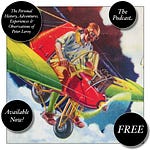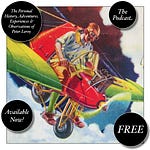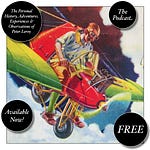OVER THE YEARS, my grandparents’ story has come out little by little. Some of their former neighbors in Punta Cachazuda, Florida, where Gumma and Guppa retired and taught clandestine classes in erotic sculpture, began exhibiting the work they had done under Gumma and Guppa’s tutelage. Newspapers picked up the story, and soon people all over America began “discovering” pieces of erotic jewelry in their closets. The work that Gumma and Guppa and others did in this line has been hailed as some of the most important American folk art of the twentieth century, but it has also been condemned as perverse and worse. I tried, until recently, to ignore it. I confess that my reason was selfish: I wanted to hold on to my child’s-eye-view of my grandparents. I wanted to hang on to Gumma and Guppa. I still clung to the comfortable and familiar notion of Gumma and Guppa that I had developed as a boy. From time to time I received requests from collectors of erotic jewelry for information about those two strangers, Herb and Lorna Piper, pleas for any little anecdote about their work in “coarse goods” — that is, erotic jewelry. I turned down all such requests with the explanation that I couldn’t say anything about their work because I never saw them at it, and I never knew that they had engaged in it until after they were dead. I never bothered trying to explain that I felt I didn’t even know Herb and Lorna Piper.
When, just a little more than a year ago, I received an invitation to attend the opening of the exhibit of American Erotic Jewelry at the Smithsonian Institution, I at first thought that I would decline that too. However, when I read, in the New York Times, that the exhibit had become the target of angry protests before it had even opened, my feelings changed. Accompanying the article in the Times was a photograph of a crowd picketing at the Smithsonian. One man stood in an aggressive posture, with his fists clenched and his chest puffed out, glaring at the camera. He wore a T-shirt with the fig-leaf emblem of the “Prude Pride” movement. Printed across it was the slogan:
I’M PROUD TO SAY
I’M ASHAMED OF MY BODY!
In the article, a spokeswoman for Mothers Against Sex was quoted as saying, toward the end of a disquisition on the pernicious effects of erotic jewelry, “A lot of people don’t realize that there’s an entire community in Florida where senior citizens turn out this perverted stuff. Can you imagine that? I ask you, America, is that how you want your grandmothers to end up — posing naked for some old perverts? It’s sick. I mean, just think of those wrinkled old people — I tell you it’s just sick. You can’t tell me that this has anything to do with artistic expression or freedom of speech. This has to do with only one thing, s-e-x.”
That did it. “Oh, no,” I said to myself. “That isn’t all there is to it. There is much, much more to it than that.”
I determined then that if my grandparents’ story was to be told, I wasn’t going to leave it to the tabloids. I was going to tell it myself, and I was going to tell it as completely as I could. In that attempt, I have drawn on my grandmother’s account, my memories of my grandparents, interviews with friends and relatives, historical documents, supposition, and imagination. Most of what they thought, felt, and experienced went unrecorded. Most of the documents they might have left were destroyed, burned in the Hapgood Brothers’ warehouse fire. I have tried, therefore, to tell the story as it probably happened. The facts may be wrong, but I think the spirit is right.
I AM INDEBTED to many people, institutions, and other sources for their help in preparing this biography, including, in no particular order, the Historical Society of Chacallit, New York; the Boston Athenæum; the Punta Cachazuda Bugle; the erotica and esoterica department at the Smithsonian Institution; the Studebaker National Museum; Asa Hall and Richard Langworth’s The Studebaker Century; Life magazine; and my parents, Bert and Ella Leroy. The book could never have been written without the reminiscences of Herb and Lorna provided by May Castle, whole chunks of which I have included unedited, just as they were transcribed from the tape recordings of our conversations. Thank you, May, for your help. I wish you had lived to read the result. I hope you would have liked it.
Peter Leroy
Small’s Island
June 2, 1987
In Topical Guide 239, Mark Dorset considers Erotica, Unsolicited and Reader Response, Unsolicited from this episode.
Have you missed an episode or two or several?
You can begin reading at the beginning or you can catch up by visiting the archive or consulting the index to the Topical Guide.
You can listen to the episodes on the Personal History podcast. Begin at the beginning or scroll through the episodes to find what you’ve missed.
You can ensure that you never miss a future issue by getting a free subscription. (You can help support the work by choosing a paid subscription instead.)
At Apple Books you can download free eBooks of “My Mother Takes a Tumble,” “Do Clams Bite?,” “Life on the Bolotomy,” “The Static of the Spheres,” “The Fox and the Clam,” “The Girl with the White Fur Muff,” “Take the Long Way Home,” “Call Me Larry,” and “The Young Tars,” the nine novellas in Little Follies, and Little Follies itself, which will give you all the novellas in one handy package.
You’ll find an overview of the entire work in An Introduction to The Personal History, Adventures, Experiences & Observations of Peter Leroy. It’s a pdf document.














Share this post